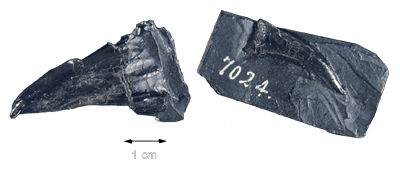What Is a Fossil? (part 2)

Illinois State Museum Colleciton
Because teeth are dense and have a hard enamel coating, they are commonly fossilized.
The skeletons of crinoids and other echinoderms are solid calcite. Some limestones are almost entirely crinoid remains.
Preserved tracks, trails, and burrows of animals, called trace fossils, are surprisingly common, considering the conditions required for their preservation.
Coprolites are fossilized feces.
Hair and fur are rarely preserved unless permanently frozen or mummified after the animal's death.
Fossils of very thin plants and animals normally make a positive and negative imprint, as in the dragonfly fossil or the fern fossil.
Internal molds of shells are produced when sediment fills the shell cavity and hardens. They record an animal's presence even when the shell has completely dissolved.
What is a Fossil part 3